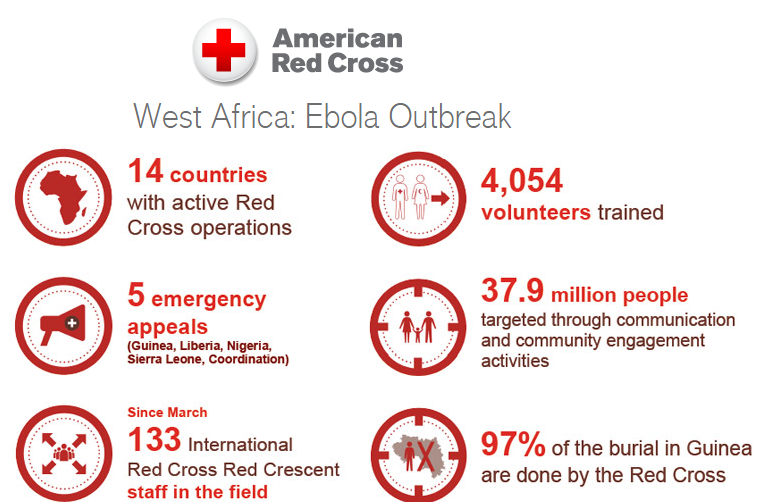Ebola has taken over the news headlines these past several months, and rightfully so. It’s so sad to see all the pain it causes for those who  cross its path. It’s also scary to see how quickly this disease can spread if not cordoned off effectively. I really hope the world steps up their efforts in West Africa to provide the help they desperately need.
cross its path. It’s also scary to see how quickly this disease can spread if not cordoned off effectively. I really hope the world steps up their efforts in West Africa to provide the help they desperately need.
To support Red Cross relief efforts in West Africa click here.
The CDC is taking the spread of this disease very seriously. After a man on an international United flight began showing one of the symptoms of Ebola the CDC came on board upon landing and took the gentleman to the hospital. The other passengers aboard the flight were temporarily quarantined, but eventually they were released and given information on the signs and symptoms of Ebola. I can’t imagine how scary it would have been to be on that flight. It was later determined that the sick passenger did not have Ebola (thank goodness!).
Apparently a nurse assistant in Spain has been infected with the disease, and I’m sure you’ve heard about Thomas Duncan, the first person in the US to be diagnosed with Ebola. Every day there’s a new story about the disease spreading. Some people are very concerned about the spread of this disease—you should have seen the mom board I’m on the day we heard about Thomas Duncan. Others are less concerned, because it’s not a disease that spreads through the air making it more difficult to transmit.
Even though most people are not concerned that we’ll see an outbreak like we are now seeing in West Africa, there are major precautions starting to take place in the US and elsewhere to try and prevent the spread. It looks like CDC staffers will soon be present at four major airports to check temperatures and question travelers about where they’ve been.
That brings me to my question. Should one of the requirements of making it through US airport security be having a temperature of less than 100° F? Not just to stop the spread of Ebola, but to help prevent the spread of all sickness. The CDC considers anyone with a 100° F temperature to have a fever.
Adding another barrier to get to your gate is probably the last thing we need, but could this be where we are heading with the Ebola scare anyways? Checking the temperature of all passengers going through security sounds like a really invasive and daunting task, but it makes me wonder if the benefits could outweigh the negatives. Technology allows us to take a temperature in just a few seconds, and if you think about it could actually prevent hundreds of thousands of illnesses.
People already are not supposed to be traveling on a plane when sick, and airlines have the right to not let you fly if they think you’re contagious, but I’ve never seen this policy enforced. However, with more and more companies expecting high productivity these days it makes the pressure to fly when sick even greater. Having this barrier in security could essentially eliminate that pressure allowing employees to get the rest they need when they’ve gotten sick on the road.
I personally don’t travel if I’m sick, and if I get sick while traveling I go to a local doctor and won’t travel back until I’m fever free for at least twenty-four hours. If checking temperatures of all passengers could be managed efficiently, and lower the chances of me catching something like the flu or anything else then I would be interested in learning more about how this would work. Unfortunately after witnessing so much disorganization over the years of traveling through airports, I don’t know if adding yet another barrier to getting through security could be sustained.
In the mean time be sure you’re washing your hands everywhere you go, and use disinfecting wipes where necessary.
Readers, what are your thoughts? Should we check the temperature of all US passengers before we let them fly?
*Note, Road Warriorette is not a doctor. Please consult your doctor before taking any medical advice.
Be sure to check out my page with products I recommend for travel!
****************************************************************************
Have a travel question or suggestion? Send it to RoadWarriorette @ gmail.com.
Follow Road Warriorette on Twitter, Facebook, and Pinterest!
This post may include affiliate links. Thanks for your support!




Body temperature can be regulated to some extent by taking aspirin, ibuprofen or other fever reducing medications. So testing temperature will not catch the infected person who is leaving africa to seek medical treatment in europe or the US.
It seems you aren’t aware that infrared thermography is common at international arrivals to screen incoming travelers ever since SARS and bird flu. If you actually even travel internationally, you may have seen these cameras at work. Or if you’ve never noticed, see how “invasive” or an intrusion of your supposed privacy it actually is.
I would contend that airlines do no screen boarding passengers with the same technology because they are not mandated by law to do so. It is an extra capital investment that they do not volunteer to make.
I don’t like bloggers who don’t do their research before posting. You might as well be a forum OP if you aren’t disseminating useful information. I do not read you for entertainment.
@Left Handed Passenger Thanks for the comment. You’re right, infrared technology sounds way less invasive and simpler than what I was imagining! Do you feel safer when you know that is being used?
I have to agree with entrada. A fever can be reduced with over the counter medicine, so taking temperatures isn’t going to actually catch a lot of the sickness. So you are burdening everyone with a broad new requirement, and you are still not going to catch most contagious people because they can just take an advil.
Compare it to school sickness programs. My kids can’t go to daycare until they’ve been fever free for 24 hours without medication, but (1) how do they regulate that to keep people from dosing up their kids and sending them in and (2) my kids still get sick, so the policy is clearly not working.